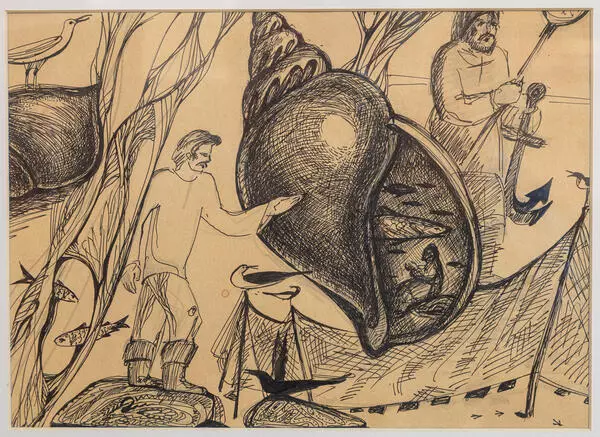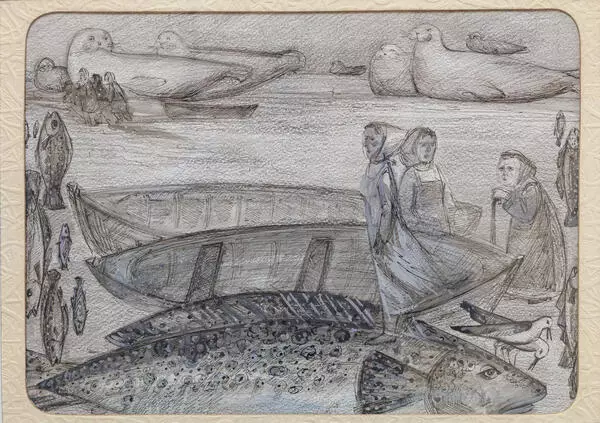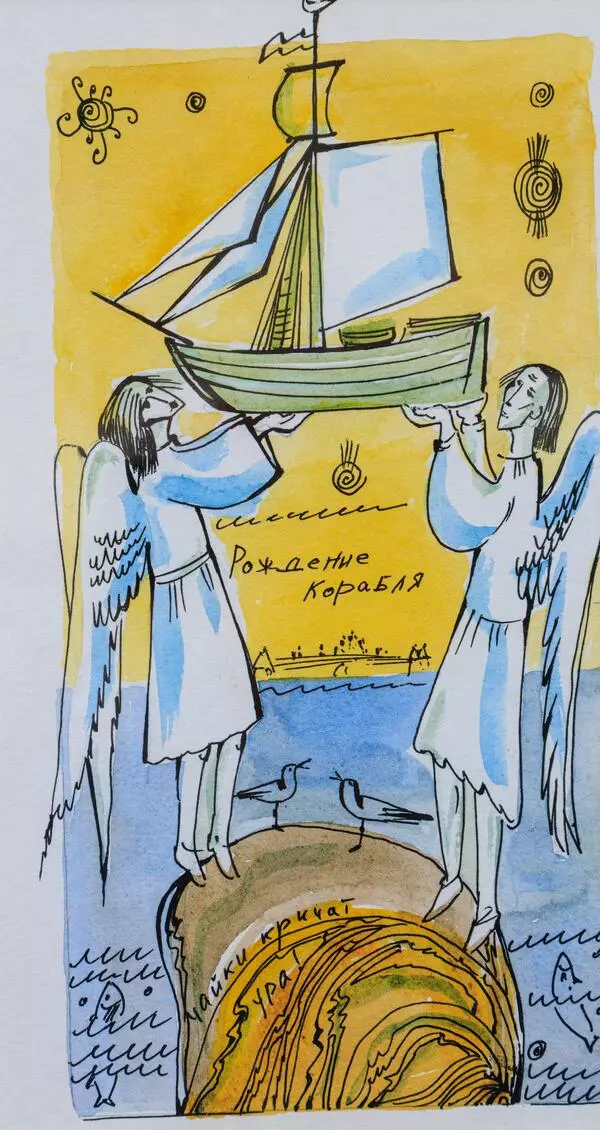‘The White Sea’ by Ekaterina Sedacheva is on display in the Primorye Arts and Crafts Museum. The picture is made in ink and watercolor on the white paper.
In the center of the painting is a large sailboat lying on one side. It is called a ‘karbass.’ Pomor fishermen usually went to sea in such sailboats propelled by oars. The boats were usually made of spruce or pine wood. Metal fasteners were not used, and all parts of the boat were fixed with dowels — round wooden nails. Usually two people sailed on small private karbass boats, while large freight karbasses could carry up to 70 people.
The artist depicted several seagulls on the side of the boat. The Pomor people had many beliefs and superstitions about these birds. For example, these birds predicted weather change. If seagulls landed on water, the day was to be nice and windless. If they flew in low circles, fussing and shrieking, it meant that the storm was coming. The Pomor people presumed that if seagulls wandered along the sandy shores, it would probably rain soon. In many cultures, seagulls were believed to be dead sailors’ souls, which could bring good fortune or warn of danger.
The figures of several women were depicted in the foreground. At the top of the picture, there is a silhouette of another boat and some birds on the waves. The boat that is turned upside down might mean that its owner has not returned from the sea voyage.
The artist Ekaterina Sedacheva was born in 1960 in the village of Pertominsk, Arkhangelsk region. At the age of 18, she graduated from the bone carving school in the village of Lomonosovo, Kholmogorsky district, and moved to Khotkovo — a town near Moscow. There she entered the Abramtsevo Higher Arts and Crafts College named after Viktor Vasnetsov. Sedacheva lectured at Art and Teacher Training College No. 35 in Arkhangelsk and was involved in folk painting, wood, and bone carving. One of the artist’s most famous work was a series based on the Mezen painting — a type of traditional northern art. Today Ekaterina Sedacheva illustrates poems and prose, paints fantastic compositions devoted to the White Sea, its inhabitants, and the people living on the coast. Most often, the artist works in watercolor, black-and-white and color graphics technique.
In the center of the painting is a large sailboat lying on one side. It is called a ‘karbass.’ Pomor fishermen usually went to sea in such sailboats propelled by oars. The boats were usually made of spruce or pine wood. Metal fasteners were not used, and all parts of the boat were fixed with dowels — round wooden nails. Usually two people sailed on small private karbass boats, while large freight karbasses could carry up to 70 people.
The artist depicted several seagulls on the side of the boat. The Pomor people had many beliefs and superstitions about these birds. For example, these birds predicted weather change. If seagulls landed on water, the day was to be nice and windless. If they flew in low circles, fussing and shrieking, it meant that the storm was coming. The Pomor people presumed that if seagulls wandered along the sandy shores, it would probably rain soon. In many cultures, seagulls were believed to be dead sailors’ souls, which could bring good fortune or warn of danger.
The figures of several women were depicted in the foreground. At the top of the picture, there is a silhouette of another boat and some birds on the waves. The boat that is turned upside down might mean that its owner has not returned from the sea voyage.
The artist Ekaterina Sedacheva was born in 1960 in the village of Pertominsk, Arkhangelsk region. At the age of 18, she graduated from the bone carving school in the village of Lomonosovo, Kholmogorsky district, and moved to Khotkovo — a town near Moscow. There she entered the Abramtsevo Higher Arts and Crafts College named after Viktor Vasnetsov. Sedacheva lectured at Art and Teacher Training College No. 35 in Arkhangelsk and was involved in folk painting, wood, and bone carving. One of the artist’s most famous work was a series based on the Mezen painting — a type of traditional northern art. Today Ekaterina Sedacheva illustrates poems and prose, paints fantastic compositions devoted to the White Sea, its inhabitants, and the people living on the coast. Most often, the artist works in watercolor, black-and-white and color graphics technique.










